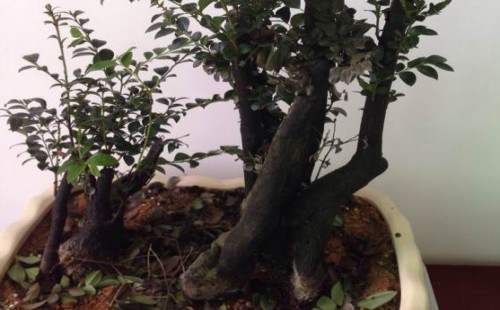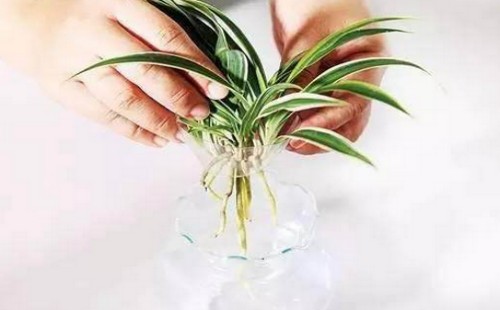Black bone tea bonsai leaves how to do
Black bone tea is a high-quality material for tree stump bonsai, and the ornamental value is very high, at the same time, the plant also has a certain shade tolerance, drought tolerance, barren tolerance, so it is very suitable for balcony, and even indoor maintenance and management. However, many friends in the maintenance and management process found that black bone tea leaves are always falling, how is this going on?

Black bone tea is a highly ornamental bonsai tree species, but once the phenomenon of loss of leaves occurs, it is bound to greatly reduce its ornamental value. So, what about the leaves of black bone tea? In order to solve the problem of leaf loss of black bone tea, we must first investigate its growth habits, conservation environment and management methods.
Black bone tea, also known as black sandalwood, originated in the tropical rain forest, because its growth is very long, and the growth is also very slow, so the old stump is very precious, it is almost impossible to find in the wild. Now the black bone tea on the market basically belongs to the variety of artificial breeding. This kind of tree has fine texture, high density and strong hardness, so it is a kind of precious tree species.
At the same time, the water resistance of black bone tea is relatively poor, in addition to the need to increase watering during the growing period, the water should be properly controlled after molding, and the air humidity is generally about 70%. At the same time, the most suitable growth temperature of black bone tea is above 20 °C. freezing damage will not occur if the lowest temperature is kept at 3 °C-4 °C. Therefore, as long as the humidity and temperature environment is maintained throughout the year, it can generally maintain normal growth.
Although black bone tea does not have high requirements for potted soil, it is not suitable for its growth. If vegetarian sand is directly used to raise it, it will often cause poor growth and the loss of leaves. Because the content of nutrient elements in vegetarian sand is very low, and there is a lack of trace elements needed for plant growth, it is also unable to provide a suitable PH value, which will increase the probability of breeding bacteria.
Therefore, the basin soil preparation of black bone tea not only uses a high proportion of sand, but also requires the soil to be fertile, loose and acidic. Generally use loess or laterite, and then mix some coarse sand, vermiculite, coconut bran, perlite and so on to improve the porosity and permeability of basin soil, and then apply a small amount of organic fertilizer as base fertilizer. In this way, the bonsai of black bone tea can meet the requirements of pot soil, so that the phenomenon of losing leaves will not be caused by improper use of soil.
Of course, the loss of leaves of black bone tea may also be caused by improper placement. Although the original black bone tea set has a certain ability to tolerate shade, after all, it is the plant that needs to receive light for photosynthesis, thus promoting growth. If it is kept indoors for a long time, it will inevitably cause lack of light, so the leaves may fall off. The recommended practice is to put the bonsai near the windowsill or balcony, not only to ensure smooth ventilation, but also to receive light to meet the needs of photosynthesis.
In addition, if the basin soil is in a moist state for a long time, especially in the case of high temperature and airtight, it is not only easy to breed diseases and insect pests, but also may lead to root rot phenomenon, but whether it is attacked by diseases and insect pests, or the phenomenon of rotten roots appears, all may cause the phenomenon of leaf loss. Therefore, the usual maintenance of the environment needs to ensure smooth ventilation, at the same time sufficient light, especially not excessive watering, adult trees generally keep the basin soil dry.
To sum up, the main reasons for the loss of leaves in black bone tea are discomfort of basin soil, lack of light, overwatering, infection of diseases and insect pests, including poor ventilation and so on. In order to improve the bad growth phenomenon of black bone tea, we need to focus on these aspects and believe that the phenomenon of losing leaves will be improved soon.
Time: 2019-05-29 Click:
- Prev

Can the small orchids cut out can be hydroponically cultured?
Hanging orchid, because it can be hung in front of the window or under the eaves can bring good embellishment to the environment and is loved by the majority of basin friends, of course, although it is a hanging orchid, it can be placed directly in the appropriate position. If it is placed indoors, it can not only be used for viewing, but also purify the indoor air.
- Next

How to raise potted Houttuynia cordata Thunb
Houttuynia cordata Thunb, which is called folded ear root in folk, is a kind of perennial herb which is both edible and medicinal. it is named because of its fishy smell. Houttuynia cordata is widely distributed in the Yangtze River Basin and many areas in the south of China, which can be divided into wild and artificial planting. Houttuynia cordata Thunb is generally propagated by means of rhizome, cuttings, ramets, etc.
Related
- Fuxing push coffee new agricultural production and marketing class: lack of small-scale processing plants
- Jujube rice field leisure farm deep ploughing Yilan for five years to create a space for organic food and play
- Nongyu Farm-A trial of organic papaya for brave women with advanced technology
- Four points for attention in the prevention and control of diseases and insect pests of edible fungi
- How to add nutrient solution to Edible Fungi
- Is there any good way to control edible fungus mites?
- Open Inoculation Technology of Edible Fungi
- Is there any clever way to use fertilizer for edible fungus in winter?
- What agents are used to kill the pathogens of edible fungi in the mushroom shed?
- Rapid drying of Edible Fungi

